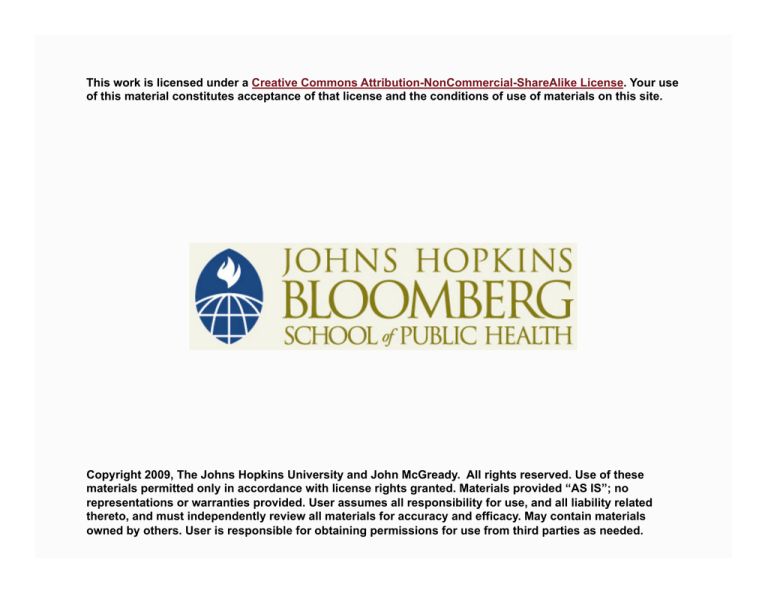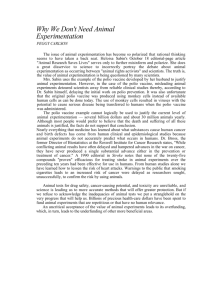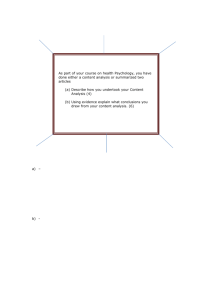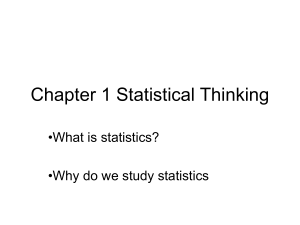
This work is licensed under a Creative Commons Attribution-NonCommercial-ShareAlike License. Your use
of this material constitutes acceptance of that license and the conditions of use of materials on this site.
Copyright 2009, The Johns Hopkins University and John McGready. All rights reserved. Use of these
materials permitted only in accordance with license rights granted. Materials provided “AS IS”; no
representations or warranties provided. User assumes all responsibility for use, and all liability related
thereto, and must independently review all materials for accuracy and efficacy. May contain materials
owned by others. User is responsible for obtaining permissions for use from third parties as needed.
Describing Data: Part I
John McGready
Johns Hopkins University
Lecture Topics
What role does statistics have in public health?
Types of data: continuous, binary, categorical, time-to event
Continuous data: numerical summary measures
Continuous data: visual summary measure
Sample data versus population (process) level data
3
Section A
What Role Does Biostatistics Play in Public Health (Why Do
I Need this Stuff?)
Data is Everywhere!
Data is utilized and summarized frequently in research literature
From Archives of Surgery article, August 2000:
- “Hypothesis: Surgeon-directed institutional peer review,
associated with positive physician feedback, can decrease the
morbidity and mortality rates associated with carotid
endarterectomy.”
- “Results: Stroke rate decreased from 3.8% (1993-1994) to 0%
(1997-1998). The mortality rate decreased from 2.8%
(1993-1994) to 0% (1997-1998). (Average) length of stay
decreased from 4.7 days (1993-1994) to 2.6 days (1997-1998).
The (average) total cost decreased from $13,344 (1993-1994) to
$9,548 (1997-1998).”
Source: Olcott IV, C., et al. (2004). Institutional peer review can reduce the risk and cost of carotid endarterectomy
Arch Surg, 135: 939-942.
5
Data is Everywhere!
Data is utilized and summarized with statistics frequently in popular
media
From cnn.com, Monday July 8th, 2008:
- “‘For the first time, an influential doctors group is
recommending that some children as young as eight be given
cholesterol-fighting drugs to ward off future heart problems
. . . With one-third of U.S. children overweight and about 17
percent obese, the new recommendations are important,’ said
Dr. Jennifer Li, a Duke University children's heart specialist.”
6
Data is Everywhere!
Data is utilized and summarized with statistics frequently in popular
media
From Washington Post, June 27th, 2008:
- “The number of young homosexual men being newly diagnosed
with HIV infection is rising by 12 percent a year, with the
steepest upward trend in young black men, according to a new
report.”
7
Data Provides Information
Good data can be analyzed and summarized to provide useful
information
Bad data can be analyzed and summarized to provide incorrect/
harmful/non-informative information
8
Steps in a Research Project
Planning/design of study
Data collection
Data analysis
Presentation
Interpretation
Biostatistics CAN play a role in each of these steps! (but sometimes
is only called upon for the data analysis part)
9
Biostatistics Issues
Planning/design of studies
- Primary question(s) of interest:
Quantifying information about a single group?
Comparing multiple groups?
- Sample size
How many subjects needed total?
How many in each of the groups to be compared?
- Selecting study participants
Randomly chosen from “master list?”
Selected from a pool of interested persons?
Take whoever shows up?
- If group comparison of interest, how to assign to groups?
10
Biostatistics Issues
Data collection
Data analysis
- What statistical methods are appropriate given the data
collected?
- Dealing with variability (both natural and sampling related):
Important patterns in data are obscured by variability
Distinguish real patterns from random variation
- Inference: using information from the single study coupled with
information about variability to make statement about the
larger population/process of interest
11
Biostatistics Issues
Presentation
- What summary measures will best convey the “main messages”
in the data about the primary (and secondary) research
questions of interest
- How to convey/ rectify uncertainty in estimates based on the
data
Interpretation
- What do the results mean in terms of practice, the program,
the population etc.?
12
1954 Salk Polio Vaccine Trial
Vaccinated
N=200, 745
Randomized
School Children
Placebo
N=201, 229
Polio Cases:
Vaccine
Placebo
82
162
Source: Meier, P. (1972), “The Biggest Public Health Experiment Ever: The 1954 Field Trial of the Salk Poliomyelitis
Vaccine,” In J. Tanur (Editor), Statistics: A Guide to the Unknown. Holden-Day.
13
Design: Features of the Polio Trial
Comparison group
Randomized
Placebo controls
Double blind
Objective—the groups should be equivalent except for the factor
(vaccine) being investigated
14
Analysis Question
Question
- There were almost twice as many polio cases in the placebo
compared to the vaccine group
- Could the results be due to chance?
15
Such Great Imbalance by Chance?
Polio cases
- Vaccine—82
- Placebo—162
Statistical methods tell us how to make these probability
calculations
16







